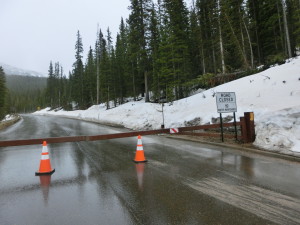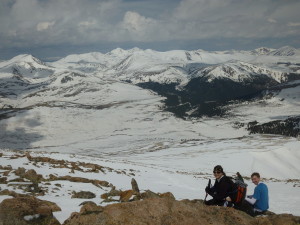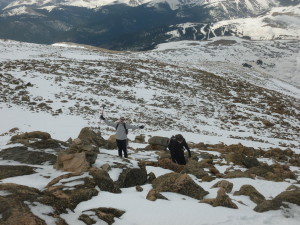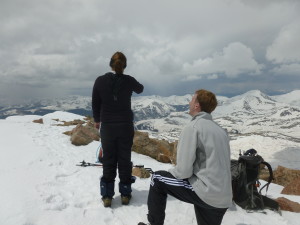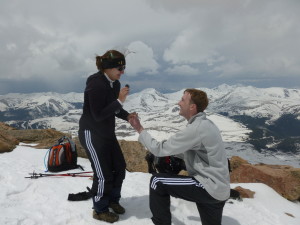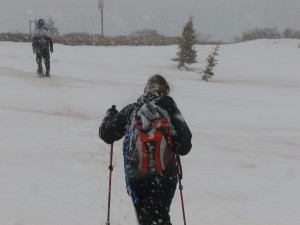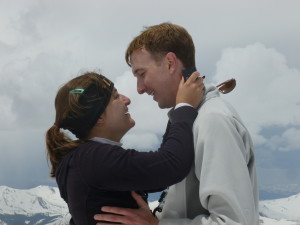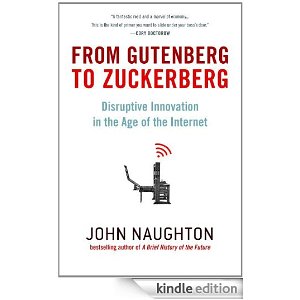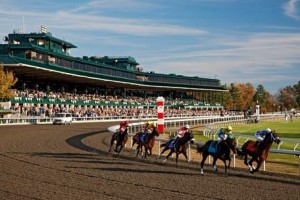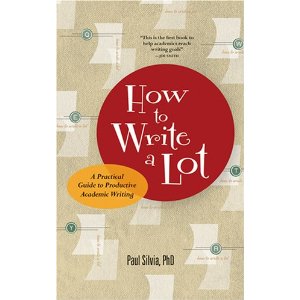Maria and I got engaged at the top of Mt. Bierstadt (14,065 ft. above sea level in Clear Creek County, Colorado) on our fourth dating anniversary: May 22, 2014. Maria recently wrote up her experiences of the day at http://www.explorethiscity.com/2014/06/rocky-mountain-front-range-co-mt.html . I suggest you read that first. I’m going to write up my side of the story for this post.
I’d been planning a mountaintop engagement since we decided to travel to Denver for a post-1st-year-of-grad-school vacation. When school ended at the beginning of May and the trip started getting close, I started looking for a good mountain to hike. To my legitimate surprise, I discovered, via trip reports on 14ers.com, that all the tallest peaks in Colorado were still snow-bound from the trailhead to the top of the mountain. I had been in Colorado in mid-May 2009 and was able to easily hike two 14ers without special equipment. The snow hadn’t started until above the tree-line (~12k feet). I thought this was normal and expected our trip in 2014 to be similar.
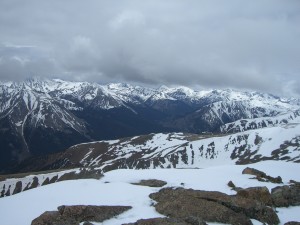
2009: Not much snow at all and basically none below the treeline.
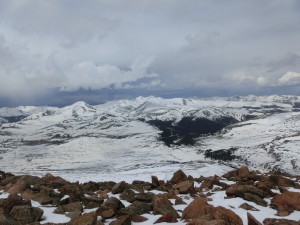
2014: Deep snow, even way beneath the tree line.
I started getting worried. Maria had never hiked a serious mountain before. Neither of us had any special equipment (snowshoes, crampons, hiking poles) and we don’t really have a ton of money to spare to buy said equipment. There was talk of constant post-holing (taking a step and having your foot fall through the snow to the ground) and some avalanche danger in the trip reports. All the people that were writing trip reports sounded like experienced climbers or skiers who had considerably more practice at climbing mountains than I did.
We flew out to Colorado, waited an hour on the tarmac to taxi to our gate due to post-tornado backup at the Denver airport, and met my friend Bryan Wallace. Bryan and I were really close friends in high school and are trying to be better at keeping in touch nowadays. Bryan wanted to join us for some hiking and had taken Thursday May 22 off to hike with us.
Maria and I went to Rocky Mountain National Park on Wednesday to get acclimated to the altitude. I was still hoping to hike a 14er on Thursday, but hadn’t decided which one. We were in good enough shape that we could easily do the Class 1 or Class 2 mountains (Elbert, Grays/Torreys, Bierstadt, Quandry, etc.) in the summertime, but some of them sounded much more treacherous this time of year. Bryan looked through the trip reports and conditions on Wednesday and suggested Bierstadt. Bierstadt wouldn’t have been my first choice in good weather conditions, but it seemed like my only choice in snow. Bierstadt had its difficulties (see below), but it was doable in the snow.
Sometime Wednesday night, long after all the shops had closed, Bryan mentioned that we could RENT snowshoes at REI. We had been at REI Wednesday morning and didn’t see any rental options. Apparently the rentals are in the basement and unmarked. REI would much rather have you purchase their overpriced equipment than rent it. So we SHOULD have rented snowshoes for our climb, but didn’t know that was an option. We would do it sans snowshoes.
Mt. Bierstadt was named after landscape painter Albert Bierstadt, who may have been the first person to summit Mt. Bierstadt and who drew a famous 12’x7’ painting titled “Storm in the Rocky Mountains” that immortalized the 14er next to Mt. Bierstadt. This peak was initially called Mt. Rosalie in honor of Bierstadt’s wife, Rosalie. The two adjacent mountains sat in marital bliss until the Colorado government thought it made more sense to honor second territorial governor of Colorado by changing Mt. Rosalie’s name to Mt. Evans. At least the naming initially made sense. If we were hiking in the summer, without snow slowing us down, we probably would have hiked Bierstadt, then crossed over to Evans via the “Sawtooth” that connects them and summited both.
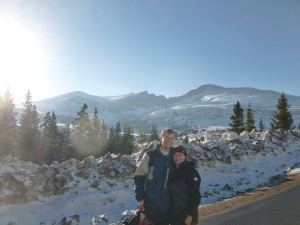
Bierstadt on the right, the Sawtooth in the middle, leading to Evans on the left. Evans’ peak might not be visible in this shot.
We left around 4am Thursday morning to drive to Bierstadt. Two hours and one winding approach later, we were staring at the winter road closure. We had to park there and walk an extra 2 miles or so to the normal trailhead. Annoyingly, the road was totally clear of snow and could have easily been opened to the trailhead. Oh well, call it a warm-up.
At the normal trailhead, Maria headed off for a potty break. It was at this point that I alerted Bryan to the fact that I was going to propose if we were able to make it to the top. I caught him totally off-guard. He recovered and agreed to take a bunch of pictures of us during the climb and at the top. Maria is addicted to pictures and I knew she would want the experience documented.
It was right after the trailhead when we hit the biggest challenge of the snow-bound Bierstadt climb. There is a long (about 2 miles) flat section of the hike before you really start gaining elevation and feel like you’re climbing a mountain. In the summer, apparently this section through the “willows” is not too bad and even has some foot bridges in places. In the winter, in 3-4 feet of snow, it was hell. Despite the cold, early start to our hike, the snow was soft and we constantly post-holed. Bryan acted as our guide and had snowshoes, but Maria and I were left to the ravages of post-holing. It’s brutal to have to constantly be climbing out of holes, only to fall back in at the next step.
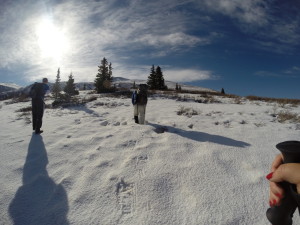
Example of Bryan post-holing past his knee, even with snowshoes.
After 100 yards of post-holing and knowing that there was around 2 miles more to go, I almost wised up and called it a day. We could try again tomorrow with the proper equipment. But May 22 is our anniversary and I really wanted to get to propose on our anniversary. I was stubborn. The objective part of my brain saw that there was only about a 50% chance we were going to make it to the top at a reasonable hour (storms typically blow in on the mountains around noon), but the emotional part of me still wanted to try, even if we ended up having to turn back later.
Bryan also told me later that, objectively, we probably should have turned back. After all, getting to the summit was only half the hike, and we would have to go through this flat stretch again on the way to the car. But he knew why I wanted to make the summit, so he pushed harder to finish the hike than he would have under normal conditions. And for that I am very grateful.
And so, we pushed on through the willows. There would be glorious sections where the snow was solid and we didn’t post-hole, but these would just lull you into a false sense of security. The first post-hole step after an easy section is the worst and just takes the breath right out of you.
Maria actually got stuck in a post-hole on the way up the mountain. The snow collapsed around her foot and both Bryan and I had to dig our arms down into the snow to free her foot.

Maria’s foot stuck in snow. She had attached her GoPro camera to her chest and set it up to take a picture every minute. She was trapped in this hole for 3 minutes as we struggled to get her out.
A year or two later, we finally made it out of the willows and started the serious ascent to the summit. We still had about 3000 feet of elevation to climb and were totally exhausted by constantly falling into the snow and having to step up and out. I honestly don’t have a lot to say about the ascent. We just kept putting one foot in front of the other until we made it up. The three of us all hiked at very different speeds. Brian and Maria were steady climbers, going nearly the same speed all the time. I’m more of a sprint and rest kind of person, so I would let them get a good lead on me and catch up in a minute or two. Then I would rest and repeat.
Toward the top, Maria was getting pretty tired. I was getting worried that we weren’t going to make the summit in time to avoid the on-coming dark storm clouds. It’s a terrible idea to be near the summit when a storm comes rolling in. I carried her bag the last stretch of the climb as we climbed over boulders, and we pushed each other to keep climbing.
We summited Mt. Bierstadt a little after noon! It was a devil of a climb up, but we made it. Maria’s first 14er and my third. I think it was also Bryan’s first or second snow ascent, though he’s done about a dozen summer summits. Maria and I had also taken the train to the top of Pike’s Peak, but that hardly counts. We took congratulatory pictures of each other and I told Maria to get a new battery in the GoPro so that we could take a video at the top.
While she was fiddling with the GoPro, I fished around in my bag for the ring. I palmed it in my hand as I explained that I wanted Maria to take a 360 degree photo of the summit with narration. Bryan saw what I had in mind, so he started taking pictures of Maria when she started filming. As she had her back to me, I dropped to one knee with the ring. She kept narrating until the camera came all the way back to me, where it had started. Then she realized what was happening.
I had a whole speech prepared, but with the exhaustion of the hike and the fear of the oncoming storm, all I was able to say was “Maria Schwartzman, here on top of the world, will you marry me?” Maria said something to the effect of “Oh my God, Yes.”
The video that Maria had started narrating ran throughout the proposal and ensuing hugs/kisses. Yes, folks, I tricked my fiancée into filming her own engagement.
After more happy pictures and celebration chocolate bars, we again noticed the storm and decided to get going. We retraced our steps through the boulders.
When we reached the part of the ascent that was clear of huge rocks, we tried our hand at glissading down the mountain. This is a technical term for sledding down the mountain on your butt. It was a lot of fun and took us down a few hundred feet, but we still had a huge hike ahead of us back to the cars.
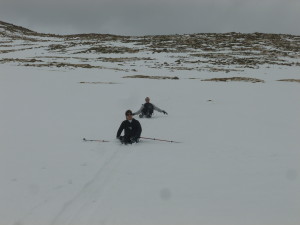
Sliding a bit of the way back down the mountain.
Once we got back to the willows, we tried a new strategy. I stole Bryan’s snowshoes and acted as a bulldozer, crushing a path through the snow that Maria and Bryan could follow. I think this, combined with the falling temperatures and hardening snow, helped us get through the willows much easier the second time. We didn’t fall into holes nearly as much and were still running on adrenaline from our summit experience.
About halfway through the willows, the storm hit. However, it didn’t fling lightning and rain at us, as expected. Instead, it started to blizzard. We made it the rest of the way to the road in a blizzard. My toes and fingers were frozen. My knees were sore from tripping on the descent once and from walking a foot at a time as I made a trail through the willows.
We hiked the couple miles down the road back to the car and made it there sometime around 4pm. Yes, it was a very long and slow 10 hour trip. Yes, we probably should have called it a day and saved some serious exhaustion about a half mile into the trip. But everyone was really pleased with the result. We conquered a really tough snow-bound climb. We got engaged! We got to butt-slide down a huge mountain. And we developed a semi-effective approach to avoiding post-holing when you only have one pair of snowshoes for multiple people. All in all, a success! Hope you enjoyed the write-up and thanks for reading!
